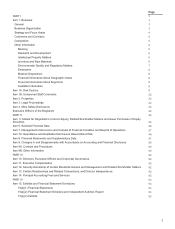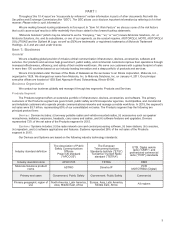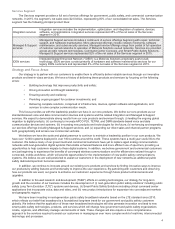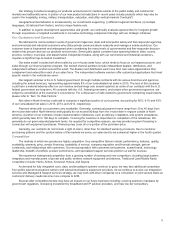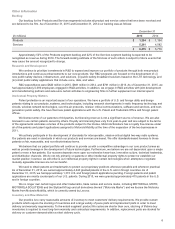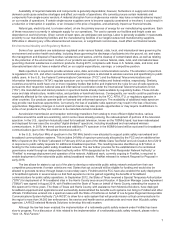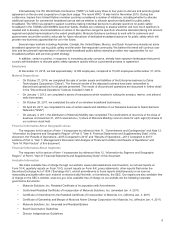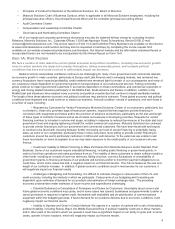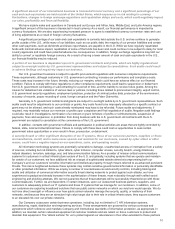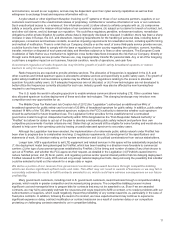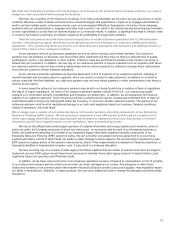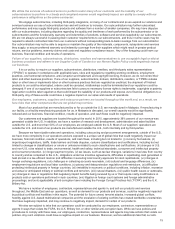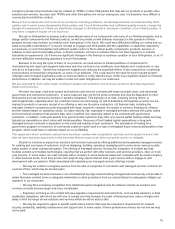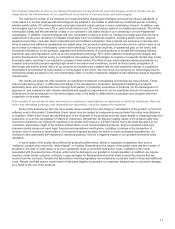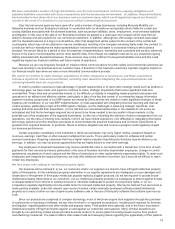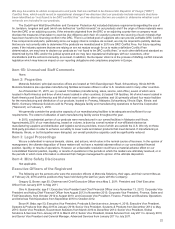Motorola 2015 Annual Report Download - page 13
Download and view the complete annual report
Please find page 13 of the 2015 Motorola annual report below. You can navigate through the pages in the report by either clicking on the pages listed below, or by using the keyword search tool below to find specific information within the annual report.12
We enter into fixed-price contracts that could subject us to losses in the event we fail to properly estimate our costs or
hedge our risks associated with currency fluctuations.
We enter into a number of firm fixed-price contracts. If our initial cost estimates are incorrect, we can lose money on these
contracts. Because certain of these contracts involve new technologies and applications, require us to engage subcontractors
and/or can last multiple years, unforeseen events, such as technological difficulties, fluctuations in the price of raw materials,
problems with our subcontractors or suppliers and other cost overruns, can result in the contract pricing becoming less favorable
or even unprofitable to us and have an adverse impact on our financial results. In addition, a significant increase in inflation rates
or currency fluctuations could have an adverse impact on the profitability of longer-term contracts.
Over the last several years we have outsourced portions of certain business operations like IT, HR information
systems, manufacturing, repair, distribution and engineering services and expect to outsource additional business
operations. This outsourcing limits our control over these business operations and exposes us to additional risk as a
result of the actions of our outsource partners.
As we outsource more of our business operations we are not able to directly control these activities. Our outsource
partners may not prioritize our business over that of their other customers and they may not meet our desired level of quality,
performance, service, cost reductions or other metrics. Failure to meet key performance indicators may result in our being in
default with our customers. In addition, we may rely on our outsource partners to secure materials from our suppliers with whom
our outsource partners may not have existing relationships and we may be required to continue to manage these relationships
even after we outsource certain business operations.
As we outsource business operations we become dependent on the IT systems of our outsource partners, including to
transmit demand and purchase orders to suppliers, which can result in a delay in order placement. In addition, in an effort to
reduce costs and limit their liabilities, our outsource partners may not have robust systems or make commitments in as timely a
manner as we require.
In some cases the actions of our outsource partners may result in our being found to be in violation of laws or regulations
like import or export regulations. As many of our outsource partners operate outside of the U.S., our outsourcing activity
exposes us to information security vulnerabilities and increases our global risks. In addition, we are exposed to the financial
viability of our outsource partners. Once a business activity is outsourced we may be contractually prohibited from or may not
practically be able to bring such activity back within the Company or move it to another outsource partner. The actions of our
outsource partners could result in reputational damage to us and could negatively impact our business, financial conditions,
results of operations, and cash flows.
We no longer own a number of our enterprise legacy information systems, including components of our Enterprise
Resource Planning (ERP) system. We are planning to implement a new ERP system and we rely on complex and in
some cases aging information technology systems and networks to operate our business. Any system or network
disruption could have a negative impact on our operations, sales and operating results.
We rely on the efficient and uninterrupted operation of complex information technology systems and networks, some of
which are within the Company and some of which are outsourced. In connection with the sale of our Enterprise business to
Zebra, we transferred ownership of a number of our enterprise legacy information systems including components of our
Enterprise Resource Planning (ERP) system to Zebra. We are currently in a transition services agreement to co-use these
systems with Zebra until 2017 which limits our ability to make changes to these systems. We are planning to implement a new
ERP system to replace pieces of the systems now owned by Zebra. If this implementation is delayed or introduces defective, or
improperly installed or implemented computer code, it may result in a business disruption.
We also currently rely on a number of older legacy information systems that are harder to maintain and when we begin to
implement our new ERP system we will have fewer resources to maintain these older legacy systems. A system failure could
negatively impact our operations and financial results.
In addition, as we have outsourced more of our business operations we have increased our dependence on the IT systems
of our outsourced business partners which are not under our direct management or control. Any disruption to either those
outsourced systems or the communication links between Motorola Solutions and the outsourced supplier, may negatively impact
our ability to manufacture, distribute, or repair products. We may incur additional costs to remedy the damages caused by these
disruptions.


